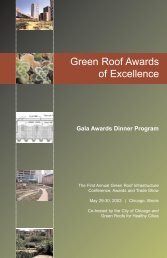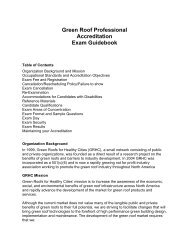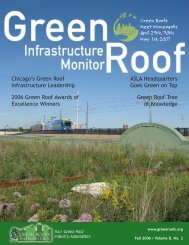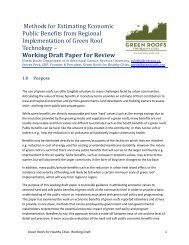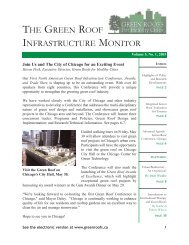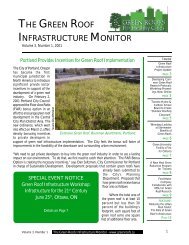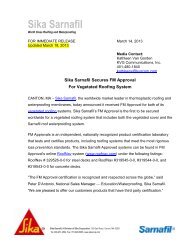Brian L. Taylor, P.E., and Drew A. Gangnes, P.E. - Green Roofs for ...
Brian L. Taylor, P.E., and Drew A. Gangnes, P.E. - Green Roofs for ...
Brian L. Taylor, P.E., and Drew A. Gangnes, P.E. - Green Roofs for ...
- No tags were found...
Create successful ePaper yourself
Turn your PDF publications into a flip-book with our unique Google optimized e-Paper software.
initial infiltration processes (13). For the ERM, rainfall losses due to evapotranspiration, depressionstorage, <strong>and</strong> canopy interception are estimated by the user using values obtained from other sources <strong>and</strong>professional judgment. Unlike SBUH, the ERM does not compute initial infiltration separately from thesustained infiltration processes discussed below.In SBUH, infiltration <strong>and</strong> surface runoff are computed from the rainfall <strong>and</strong> the runoff curve number (CN)selected from st<strong>and</strong>ard tables of soil type <strong>and</strong> cover, initially developed by the Soil Conservation Service(14). Once rainfall exceeds the initial abstraction, the amount of runoff generated is calculated from therainfall <strong>and</strong> CN, using an empirical-based relationship. In the ERM, the infiltration rate provided by thedesigner is compared to the rainfall intensity to determine if water infiltrates or runs off the surface of theeco-roof. The infiltration rate is established from testing, observed eco-roofs, <strong>and</strong>/or the soil mediaspecification. The ERM assumes the infiltration rate is constant; the saturated infiltration rate is used <strong>for</strong>Seattle design storms.Soil moisture is not explicitly modeled in SBUH, but is inherent to the CNs <strong>and</strong> empirical runoff equation.In the ERM, at each time interval, the ultimate retention capacity of the media is compared to theaccumulated retained water. The first amount of moisture that soaks into the media contributes tosatisfying the ultimate field capacity of the media. Once the field capacity is used, subsequent infiltratedrainwater is held as transient storage in the media voids. Initial saturation <strong>and</strong> field capacity of the soilmedia determine the ultimate retention capacity <strong>for</strong> a scenario.Flow attenuation due to water percolating through soil layers is not represented in SBUH because waterthat infiltrates is assumed to go into deep soils <strong>and</strong> not contribute to runoff (6). In the ERM, an eco-roofsoil media layer is modeled as a reservoir. The storage capacity is determined by the depth <strong>and</strong> effectiveporosity of the media, where the effective porosity is the portion of the soil volume that provides transientstorage. The attenuation of water flowing through the porous media is computed by the hydrologicrouting procedure described below. Water cascades through the layers, so the discharge from the firstsoil media layer is the inflow to the second layer, <strong>and</strong> so <strong>for</strong>th.Surface runoff attenuation is computed in SBUH by the modified Att-Kin hydrologic routing procedure,using a routing coefficient equal to the “time-of-concentration” <strong>for</strong> the basin (4, 15). Hydrologic routingis a procedure to determine how much inflow peaks are delayed <strong>and</strong> reduced as water flows throughwater storage reservoirs. The attenuation is based on an open channel with characteristics that matchthe basin. The routed-flow rate is the predicted basin discharge. In the ERM, although surface runoff isnot expected, the same method is applied to surface runoff <strong>and</strong> separately <strong>for</strong> seepage flow to account<strong>for</strong> attenuation that occurs as flow is conveyed to the roof drain. The sum of routed surface <strong>and</strong> seepageflows is the net eco-roof discharge.HYDROLOGIC ROUTING FOR ECO-ROOFSTo account <strong>for</strong> attenuation as flow percolates through the eco-roof, a modified Att-Kin procedure is usedto model transient storage provided in the eco-roof voids. The procedure uses a storage coefficientbased on the relationship between the volume of water stored <strong>and</strong> the rate of release (15). For a basinwith open channel conveyances the storage coefficient can be estimated as the time-of-concentration,whereas a different coefficient is needed <strong>for</strong> freely drained porous media. The theoretical storagecoefficient <strong>for</strong> an eco-roof soil layer can be computed from the media depth, infiltration rate, <strong>and</strong>Method <strong>for</strong> Quantifying Runoff Reduction of <strong>Green</strong> <strong>Roofs</strong><strong>Brian</strong> L. <strong>Taylor</strong>, P.E., <strong>and</strong> <strong>Drew</strong> A. <strong>Gangnes</strong>, P.E.5




